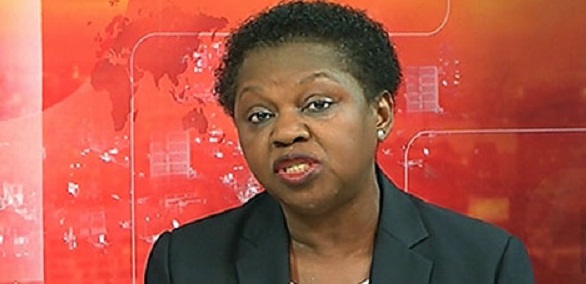Aeroportos de Moçambique's losses double in 2024
Moza Banco had negative solvency ratio – Mozambique’s Central Bank supervision director

O País / Director for banking supervision of Banco de Moçambique, Joana Matsombe, speaking to STV news channel on Sunday, October 3, 2016.
The Bank of Mozambique was obliged to intervene in the fourth largest of Mozambique’s commercial banks, Moza Banco, because its solvency ratio had gone negative, according to the director for banking supervision of the central bank, Joana Matsombe.
The solvency ratio of any company is calculated by dividing net income and depreciation by total liabilities. In general, the higher the ratio the more financially sound the company is. But a low solvency ratio may indicate that the company will find it difficult to meet its obligations.
Interviewed by the independent television station STV, Matsombe said the solvency ratio of a bank should not fall below eight per cent. But in Moza Bank’s case, the solvency ratio was “below zero”.
“For this reason, the financial situation of the bank had deteriorated, and it was incapable of meeting its obligations”, she said. “When this happens, in any financial institution, the central bank has to intervene”.
That intervention, Matsombe added, meant that all deposits in the bank were guaranteed. The intervention was intended to protect the clients of Moza Banco, but also to avoid any run on the banks.
“Nobody needs to go to the bank and withdraw their money, because it’s safe”, she said. “As from now, the central bank will manage Moza Banco through the provisional Board of Directors it has appointed”.
The provisional board, Matsombe continued, has the job of restoring the financial stability of Moza Banco, trying to clear up any non-performing loans, and preparing the bank for sale, a process that should take no longer than six months. “The only problem the bank had was that capital had not been injected to restore the solvency ratio”, she said.
As for the shareholders, Matsombe made it very clear that the central bank was much more concerned about the clients.
“The shareholders should have put more capital into the bank. That’s their job”, she said. “When the ratios that indicate the solidity of the bank deteriorate, it is the duty of the shareholders to inject new capital”. Indeed, the central bank had urged them to do so, and it was only after no new capital was injected that it intervened to bail out Moza Banco.
The former chairperson of Moza Banco, Prakash Ratilal (who was once governor of the Bank of Mozambique), blamed the fall of the bank on a liquidity crisis. “It’s lack of capital and lack of liquidity”, he told STV. “The situation of the Mozambican economy is very difficult. Many companies are closing their doors, and there are also companies who are delaying payments. This compromised what we were expecting to receive”.
“There’s a shortage of liquidity, because the economic situation is very tough”, he insisted. “All the banks have difficulties. There is a greater or lesser capacity to capitalize, and we Mozambicans have less capacity”.
Nonetheless, Ratilal believed that the bank was essentially sound. “On Monday (the first working day after the central bank’s intervention) the doors of the bank will open normally”, he said. “All the cheques will be paid, all the depositors can stay calm, because the bank is good, the fundamental pillars of the bank are solid”.
Ratilal said no crimes had been committed, nobody was being punished, and nothing untoward had been found in any audit of the bank. The problems of Moza Banco had nothing to do with the original foreign partner, the Portuguese Banco Espirito Santo, where there really had been criminal proceedings.
Moza Banco is the only bank where Mozambicans hold a majority of shares. The Mozambican shareholder is Mocambique Capitais, which consists of about 400 Mozambican investors.
The foreign investor was initially BES. But after BES came near collapse in 2014, and had to be bailed out by the Portuguese central bank, its healthy assets (including the 49 per cent holding in Moza Bank) were spun off into a new entity, Novo Banco. But it seems that Novo Banco was unable or unwilling to inject new funds into Moza Banco.
Moza Banco was founded eight years ago, and grew rapidly. The latest research on the banking sector, from 2014, undertaken by the consultancy company KPMG, in partnership with the Mozambican Association of Banks, showed that Moza Banco had a 7.2 per cent market share.
Only three banks had a larger share of the Mozambican market – Millennium-BIM (30 per cent), BCI (29 per cent) and Standard Bank (14 per cent). Moza Banco had overtaken Barclays-Mozambique, whose market share had fallen to 6.8 per cent. Several smaller commercial banks accounted for the remaining 13 per cent.












Leave a Reply
Be the First to Comment!
You must be logged in to post a comment.
You must be logged in to post a comment.